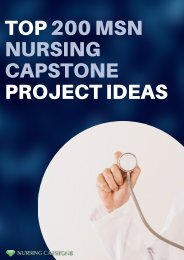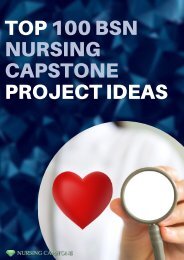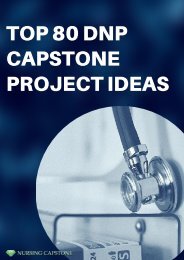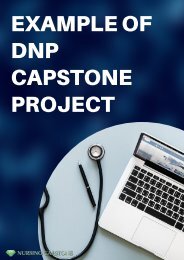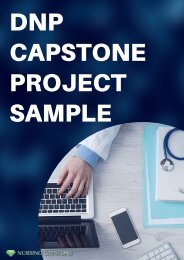Nursing Capstone Paper Sample
Hi! Take a look at this article with the best nursing capstone paper sample. Get more samples here https://www.nursingcapstone.net/examples-of-capstone-projects-for-nursing/
Hi! Take a look at this article with the best nursing capstone paper sample. Get more samples here https://www.nursingcapstone.net/examples-of-capstone-projects-for-nursing/
You also want an ePaper? Increase the reach of your titles
YUMPU automatically turns print PDFs into web optimized ePapers that Google loves.
NURSING<br />
CAPSTONE<br />
PAPER<br />
SAMPLE
Implementation Plan for <strong>Nursing</strong><br />
Implementation planning is a tool used to make the nursing implementation plan<br />
effective. The study has provided an insight of how the nursing implementation plan<br />
should be created. The various elements of implementation plan for nursing has been<br />
put forth. Some of those elements that have discussed include; methods for obtaining<br />
necessary approvals, description of the problem, proposed solution and rationale<br />
utilized in selecting the proposed solution. Other elements include; review of the<br />
literature, implementation logistics, and resources utilized for implementation have<br />
also been put forth.<br />
The methods for evaluating the effectiveness of the program have also been<br />
discussed. Besides, it can be observed that the outcomes of the implementation will<br />
lead to a decrease in cases of the cancer problem. <strong>Nursing</strong> staff will also be in a<br />
position to use the education knowledge to manage and control the problem. The new<br />
policies will help the government and private entities to subsidize the cost of cancer<br />
treatment as discussed.<br />
Introduction<br />
An implementation plan in nursing entails comprehensive steps that will be followed in<br />
developing a nursing project. The implementation plan normally acts a tool utilized to<br />
execute a nursing project and ensures that it become a success. The nursing<br />
professionals utilizes the implementation plan to provide them with a blue print on<br />
what they should concentrate implementing. Besides, the nursing implementation plan<br />
helps to eliminate wastage of time and resources because it clearly states what is to be<br />
implemented and the duration it will cover. Besides, it helps to ensure that the scope of<br />
the nursing project has been well addressed. Besides, prior making any<br />
implementation in the <strong>Nursing</strong> practice necessary consultation and evaluation exercise<br />
must be carried out to prevent future conflicts among the stakeholders. In addition, the<br />
implementation plan for nursing helps the nursing professionals to be conscious of the<br />
events that are about to unfold in their areas of practice. It makes sure that everyone is<br />
pro-active rather than reactive. It enables the nursing professionals to identify a<br />
problem before it happens. Besides, the nursing implementation plan helps the nursing<br />
professionals to be fully aware of their actions and responsibilities such that each<br />
person can execute her professional duty as required. In addition, the nursing<br />
implementation plan ensures that nurses are aware of the program goals and specific<br />
objectives that need to be achieved by the end of the program.
Therefore, when preparing an implementation plan for nursing project, nurses should<br />
be able to understand the cost and benefits of the plan. They should also be fully<br />
aware of the inherent risk that may be encountered when carry out project<br />
implementation. However, the cost of implementing the nursing plan should not<br />
outweigh the benefits. Therefore, this study focuses to provide an insight of the<br />
nursing implementation plan as discussed (Bulechek, Butcher, & Dochterman, 2008).<br />
PREPARING AN IMPLEMENTATION PLAN<br />
The nursing educators play a critical role of preparing, implementing and carrying<br />
out evaluation of the nursing plan. They tend to have advanced education<br />
background and detailed experience in the nursing filed. Besides, the nursing<br />
educator tends to be a person who has been fully registered by the nursing board<br />
among other professional nursing bodies to execute the roles/duties of a nurse.<br />
Therefore, when carrying out the role of implementing the nursing plan the following<br />
seven elements discussed in detail must be included to ensure that the nursing plan<br />
is effective.<br />
Method of obtaining necessary approval(s) and securing support<br />
The implementation of the nursing programme especially that involves the<br />
population is free from chronic diseases such as cancer is a very sensitive affair<br />
because it involves a matter of life and death. Most of the programmes involve<br />
human health and hence, all the programmes must get the necessary approvals to<br />
ensure that they do not compromise the health of the patients and the society at<br />
large. Besides, such programmes demand a huge financial investment and such<br />
budget can only be met if necessary approvals from the senior leaders of the<br />
organisation get approved, hence, there are two main methods of approval that that<br />
nursing professionals may obtain to ensure that their programmes become<br />
approved. The two common types of approvals that one may obtained include;<br />
informal and formal approval. The informal approval may be obtained from the pear<br />
staff nurses and leaders within the organisation (Orto, Hendrix, Griffith, & Shaikewitz,<br />
2015).<br />
One may get approval from the peers within the organisation by selling the idea to<br />
them and showing how they will benefit if they support the implementation of the<br />
new nursing programme. Besides, one may convince them how the programme will<br />
not only be beneficial to the organisation but also to the entire members of the staff.<br />
One should show the peers how the nursing programme will benefit them and make<br />
their work easier by making their work easier than before. In addition, one should<br />
provide the peers with the necessary information prior introducing the new nursing<br />
program onto the organisation.
Some peers may acts as a barrier towards implementation of the new nursing<br />
program if they were not fully informed about the new changes that will be adopted.<br />
The barriers may also be caused by fear for unknown as the peers may feel that the<br />
new program will threaten their position in the organisation. Other may feel that the<br />
new program may require them to undergo via training and most of the peers may<br />
not be ready. Therefore, it is imperative to inform the peers earlier about the new<br />
program prior implementation so that one can get their support. Besides, one should<br />
provide them with some little training and let them discover the benefits of the<br />
program. Such actions may be imperative to obtain the necessary inform support.<br />
On the other hand, one may get the formal program approval from the nursing<br />
regulators and nursing professional bodies through a numbers of ways. The approval<br />
may also be obtained from the Institution review board. Some of the ways that might<br />
be utilized include; preparing a proposal detailing how the programme will benefit<br />
the patients and members of the medical fraternity. Secondly, one may ensures that<br />
all the standards and policies regulations have been met to get the necessary formal<br />
approval. Besides, one has obtained necessary legal accreditation and certifications<br />
required by the to get the necessary approvals (Fishman, Lowe, & Ryan, 2016).<br />
Description of current problem, issue, or deficit requiring a change<br />
There has been an increase in cases of deaths attributed to cancer. Such high<br />
motility death has been attributed to the lack of qualified nursing professionals to<br />
take care of the escalating number of patients who have been diagnosed with<br />
cancer. The role of nursing professionals cannot be ignored when it comes to<br />
treating and taking care of the cancer patients. Research indicates that cancer can<br />
only be effectively controlled and managed if the government and society at large<br />
commit their resources and efforts towards training and employing highly qualified<br />
nursing staffs. Besides, lack of proper education in managing cancer has led to an<br />
increase in cases of cancer. Lack of proper public awareness on early detection and<br />
prevention of cancer have increased the cases of cancer deaths because most<br />
people are not aware of the importance of early detection and prevention of cancer<br />
at an early stage before it has become chronic. In addition, lack of adequate funding<br />
to manage and curb the spread of cancer has been a big problem Lack of necessary<br />
funds has made it impossible to acquire the required machines to test and detect<br />
cancer before the patient’s condition worsen. Majority of the patients have not been<br />
in a position to fully access the medicine and treatment and hence, causing the<br />
management of the disease to become a challenging task (Fishman, Lowe, & Ryan,<br />
2016).
Detailed explanation of proposed solution<br />
There is need to establish a reliable policy, process, procedures and also provide<br />
necessary education to address the problem of cancer. The government should<br />
establish credible institutions to train professional nurses. Besides, the government<br />
should work collaboratively with the society to ensure that members of the public are<br />
provided with necessary education that give them awareness on measures that can<br />
be put forth to curb the escalating cases of cancer. The members of the public should<br />
be encouraged to seek medical attention to solve the problem of cancer. The policies<br />
that address the various types of cancers independently should be established.<br />
Besides, there should be proper amendments on the policies to ensure that some<br />
types of cancers have been factor in and address properly. The new policies will help<br />
to ensure that the various types of cancers are analysed into details, this will help to<br />
ensure that the implementation of the nursing program become a success. Another<br />
proposed solution to the problem is to avail the necessary financial support to ensure<br />
that, nursing professionals have proper access to the medical equipments. Besides,<br />
the cost of treating cancer have been significantly high, the government should<br />
subsides such cost by providing cancer patients with medical insurance that may<br />
help to cater for the high treatment cost. Another solution may involve creating<br />
public awareness such that members of the public can seek medical attention at an<br />
early stage before the cancer become chronic at the late stages (Buchanan, Geerling,<br />
& Davies, 2014).<br />
Rationale for selecting proposed solution<br />
The above proposed solutions were solution were made because in order to fight<br />
cancer and curb its spread. There should be collaboration between the government,<br />
non-governmental organisation, individuals members of the public and society at<br />
large to ensure that the problem of cancer is addressed successfully. The<br />
establishment of education institutions will play an imperative role towards ensuring<br />
that the necessary knowledge and skills to fight against cancer has been passed to<br />
the members of the society. Besides, the establishment of the cancer awareness<br />
campaigns will help in early detection and prevention of cancer cases (Buchanan,<br />
Geerling, & Davies, 2014).<br />
Evidence from your review of literature<br />
The literature has also played a role towards shedding right to the problem of cancer.<br />
According to Borglin and Gustafsson, the theory education given to the nurses is<br />
imperative because it equip nurses with vital knowledge to alleviate pain among the<br />
cancer patients.
Borglin and Gustafson further asserted that approximate sixty eight percent of the<br />
nurses who have received theoretical education tend to be less compenetent when<br />
carrying out their routine functions. It implies that the nurses should not only be<br />
provided with theoretical knowledge but rather they should also be equipped with<br />
practical skills so that they can handle cancer cases with a lot of competence.<br />
Besides, Buchanan asserted that cancer can be treated and managed only if there is<br />
availability of competent and qualified personnel’s. He also asserted that the<br />
diseases can be curbed if there is availability of competent medical practitioners such<br />
as nurses and doctors. Besides, financial aid should be provided when dealing with<br />
cancer cases, lack of adequate funding especially in Africa countries have caused a<br />
serious problem of having numerous cases of cancer conditions. Majority of the<br />
people in those areas cannot afford to meet medical expenses for cancer (Buchanan,<br />
Geerling, & Davies, 2014).<br />
Description of implementation logistics<br />
The change will be integrated into the current organisation structure culture and<br />
workflow via six steps discussed. The first step for effective implementation wills<br />
entail obtaining necessary approval both formal and informal approval from the<br />
board of institutional review (IRB). The second implementation phase entails<br />
planning and projects design; under this resources to be used to implement the<br />
nursing programme are harnessed. The third implementation phase entails carting<br />
out the research to identify whether the project will be viable. It involve finding out<br />
whether the project benefits will outweigh the disadvantages. The fourth step entails,<br />
providing the staff with relevant education that so that they can easily implement the<br />
program. It may help the staff members to learn on what they are expected to do.<br />
Normally, the phase takes duration of 6 months to be complete. The fifth step entails<br />
overseeing the launch of the project. The actual implementation exercise take place<br />
at this stage and recommendation made on whether or not to continue with the<br />
program (Buchanan, Geerling, & Davies, 2014).<br />
Resources required for implementation<br />
Resources will be needed to make the program become a success. The education<br />
materials such as PowerPoint, handouts, pamphlet and posters will be needed in<br />
order to educate the employees about the program. Besides, staffs will be assessed<br />
to see whether they have gain value from the education. It implies that<br />
questionnaires, surveys, and posters will be needed. Funding will also be avail to<br />
finance employee’s salaries and purchase of necessary equipments (Buchanan,<br />
Geerling, & Davies, 2014).
EVALUATION PLAN<br />
Discuss methods to evaluate the effectiveness of your proposed solution.<br />
A number of methods will be utilized to see whether the proposed solution was<br />
effective. Some of the methods that will be employed include; staff turnover rates,<br />
surveys, comparison methods to mention just but a few. The turnover rates will be<br />
used to determine whether there is a reduction in staff turnover rate after<br />
implementation of the new proposed solution. In case there is a decrease it will imply<br />
that the proposed solution is effective. A decrease in the staff turnover rate implies<br />
more nurses are satisfied and are willing to work in their respective health centres<br />
and are less likely to leave. Surveys will be utilized to evaluate whether there has<br />
been changes in employees attitude toward job satisfaction after the new changes<br />
were established. The comparison method will help to determine whether there has<br />
been a change in the number of patients discharged from the hospital. If there is an<br />
increase it wil, imply that the proposed solution was effective and should be<br />
reinforced. On the contrary, if there is a decrease it implies that the proposed solution<br />
was not effective and therefore, new methods should be adopted.<br />
Describe what your projected outcomes will be and what variables will be assessed.<br />
The anticipated project will be a reduction in the cases of cancer cases because<br />
members of the public will be able to use the education and knowledge acquired to<br />
manage and control the prevalence of the diseases. Besides, there will be more<br />
competent and qualified nursing staff to deal with cases of cancer at different levels.<br />
In addition, there will be a few cases of cancer to be reported as more nursing staffs<br />
will be able to create public awareness on early detection and treatment. Morover,<br />
there will be few incidence of the death as a results of cancer because patients will<br />
be fully aware on how to deal with cancer problem. The variables that will be<br />
assessed include the attitude and perception of the patient, and employees each of<br />
them independently. Besides the turnover rate of the nursing staffs will also be<br />
assessed accordingly.<br />
Conclusion<br />
Based on the study it can be scrutinized that an implementation plan in nursing<br />
entails comprehensive steps that will be followed in developing a nursing project. It<br />
can be observed that for the nursing implementation plan to be effective, all the<br />
seven elements discussed must be taken into consideration.
The first element entails obtaining necessary approval(s) and securing support<br />
needed to implement the project effectively, the support entails both informal and<br />
formal support. Some of the ways to get support include; showing the peers the<br />
benefits that they will obtain by accept to support the project and also obtain support<br />
from the institutional review board to mention just but few.<br />
The second element entails problem description; it can be observed that cancer<br />
has been a big challenge in the world and especially in most African countries due to<br />
lack of highly qualified nursing staffs and lack of funding. The third element has<br />
provided a detail explanation of the proposed solution and literature evidence has<br />
also been discussed. Implementation logistics and resource needed to implement<br />
the program have also been put forth. Conclusively, the methods for evaluating the<br />
solutions proposed have been discussed as well as the outcomes and the variables<br />
to be involved.<br />
References<br />
Buchanan, A., Geerling, J., & Davies, A. (2014). Breakthrough cancer pain: the role of<br />
the nurse. International Journal of Palliative <strong>Nursing</strong>, 20(3), 126-129.<br />
Bulechek, G. M., Butcher, H. K., & Dochterman, J. M. (Eds.). (2008). <strong>Nursing</strong><br />
interventions classification (NIC). Mosby.<br />
Fishman, N. W., Lowe, J. I., & Ryan, S. F. (2016). Promoting an Alternative to<br />
Traditional <strong>Nursing</strong> Home Care: Evaluating the Green House Small Home Model. An<br />
Introduction from the Funders and the Green House Project. Health Services<br />
Research, 51(S1), 344-351.<br />
Orto, V., Hendrix, C. C., Griffith, B., & Shaikewitz, S. T. (2015). Implementation of a<br />
Smart Pump Champions Program to Decrease Potential Patient Harm. Journal of<br />
nursing care quality, 30(2), 138-143.<br />
CHECK OUT THE BEST EXAMPLES OF CAPSTONE<br />
PROJECTS FOR NURSING AND ASK US FOR<br />
MORE HELP!






